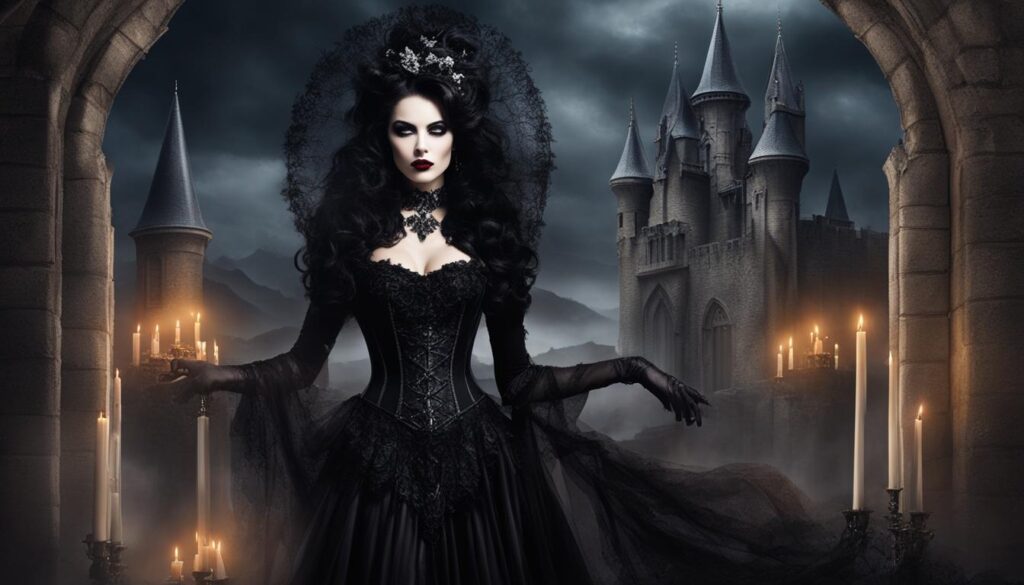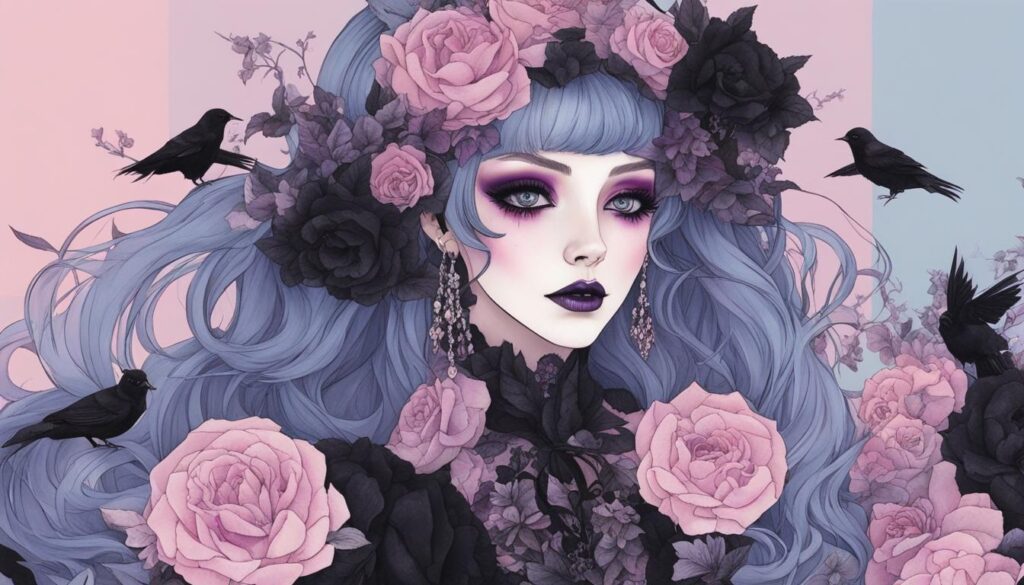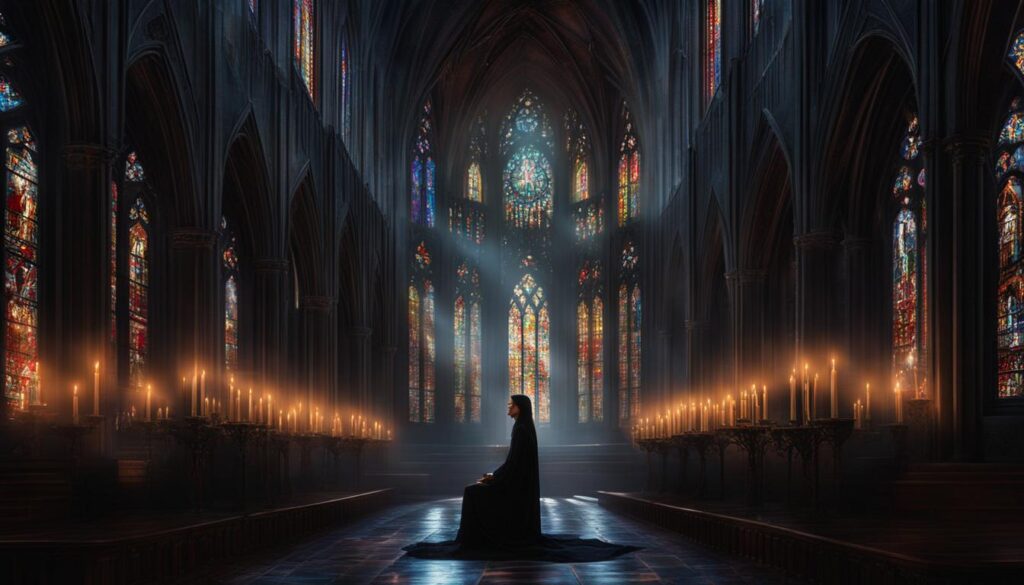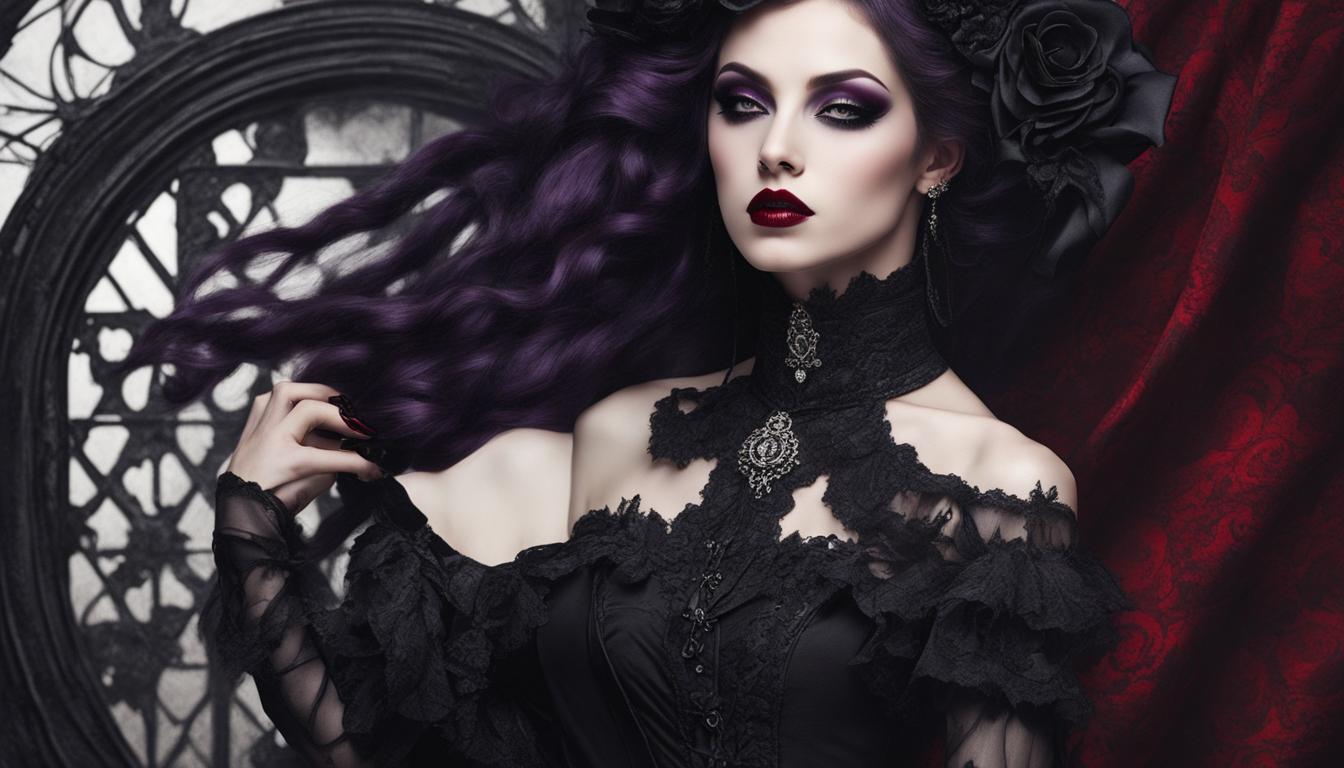Goth culture, a captivating and enigmatic subculture, has intrigued and fascinated people for decades. But what is goth, exactly? Dive into the dark and mysterious world of goth as we explore its origins, fashion styles, music, and unique aesthetic.
Goth subculture emerged from the rock and punk music scene in the 70s and 80s. Contrary to popular belief, being goth does not mean embracing anger or evil. It is a diverse and expressive subculture that embraces dark, mysterious, and morbid elements, offering a multitude of fashion styles, musical tastes, and beliefs.
Key Takeaways:
- Goth subculture originated from the rock and punk music scene in the 70s and 80s.
- Being goth does not mean embracing anger or evil.
- Goth subculture is characterized by a love for dark, mysterious, and morbid elements.
- Goth encompasses various fashion styles, musical tastes, and beliefs.
- Goth subculture is one of the most popular subcultures globally.
The History of Goth
The goth subculture emerged in the 70s and 80s, influenced by bands such as Siouxsie and the Banshees, The Cure, and Joy Division. These goth pioneers popularized the gothic style, which eventually led to the development of the goth subculture as we know it today. Goth subculture encompasses various fashion styles and musical tastes, making it a unique and diverse subculture within the larger scope of the gothic subculture.
Goth fashion is characterized by its dark and mysterious aesthetic. It often includes elements such as black clothing, leather, fishnets, and bold makeup. The music associated with goth subculture is typically dark, often incorporating elements of rock, punk, and post-punk. Bands like Bauhaus, The Sisters of Mercy, and Fields of the Nephilim are closely associated with the goth music genre.
Over the years, goth subculture has evolved and gained popularity in countries around the world, including Japan, Germany, and the United States. It continues to be a symbol of self-expression and individuality, providing a space for those who identify with its unique style and ethos.
Notable Gothic Subculture Pioneers:
- Peter Murphy
- Siouxsie Sioux
- Robert Smith
- Andrew Eldritch
- Ian Curtis
“Goth culture is about embracing the beauty in darkness and exploring the mysteries of life.” – Peter Murphy
Common Misconceptions About Goth
Despite its global popularity, the goth subculture is often surrounded by various misconceptions and stereotypes. Let’s debunk some of the most common myths about goths:
1. Goth Stereotypes: Angry and Depressed
One of the most prevalent stereotypes about goths is that they are angry and depressed individuals who embrace darkness and negativity. However, this couldn’t be further from the truth. While goths do appreciate the beauty and allure of dark elements, they are not defined by anger or sadness. Goths are expressive individuals who find solace in exploring the deeper and more mysterious aspects of life.
2. Goth Fashion: All Black Everything
Another misconception is that goth fashion is solely characterized by an all-black wardrobe. While black clothing is certainly prevalent in goth fashion, it is not the only option. Goths embrace a wide range of styles, from traditional goth to romantic goth, cyber goth, and more. Their fashion choices are diverse, and they often experiment with different colors, textures, and accessories to create unique and expressive looks.
3. Goth Emotions: Only Dark and Morbid
Goths are often assumed to have a singular range of emotions, limited to dark and morbid feelings. However, goths, like anyone else, experience a wide spectrum of emotions. They can be happy, passionate, and optimistic individuals who appreciate the beauty in both light and shadow. Goth culture encourages self-expression and the exploration of emotions, allowing goths to embrace their unique experiences and perspectives.
4. Goth Beliefs: Embracing Evil and Satanism
Perhaps one of the most persistent misconceptions is the association of goth culture with evil and satanism. While some goths may explore occult and alternative spiritual beliefs, it is important to recognize that goth subculture itself is not inherently evil or satanic. Goths appreciate aesthetics that are often considered dark or macabre, but this does not define their personal beliefs or values.
Traditional Goth Style

Traditional goth style, also known as trad goth, is deeply rooted in the early gothic music and fashion styles of the goth subculture. It draws inspiration from the rock and punk scene of the 70s and 80s, when bands like Bauhaus and The Sisters of Mercy emerged as pioneers of the genre. Traditional goths often embrace a darker version of the rock-inspired looks, donning black leather jackets, boots, fishnet stockings, and ripped shirts.
This style is all about embracing the mysterious and macabre, with a touch of rebelliousness. Traditional goths are known for their dark and moody aesthetic, often incorporating symbols like crosses, pentagrams, and other gothic motifs into their fashion choices.
While traditional goth fashion is a significant aspect of the style, it is closely intertwined with the music that defines the subculture. Bands like Bauhaus, The Cure, and Siouxsie and the Banshees have been instrumental in shaping the traditional goth sound. The music often features haunting melodies, intense atmospheres, and introspective lyrics that resonate with the deeper emotions of the goth community.
Romantic Goth Style
Among the various styles within the goth subculture, one that stands out for its elegance and dark aesthetic is the romantic goth style. Drawing inspiration from early Victorian literature and fashion, romantic goths appreciate the beauty in concepts like dead roses, moonlit graveyards, and tragic love stories. This style combines the allure of the gothic with the refinement of Victorian fashion.
Romantic goths often incorporate black clothing with colorful highlights, adding a touch of whimsy to their ensembles. They embrace both the darkness and the light, merging elements of the macabre with touches of brightness. It’s a style that allows for self-expression and creativity, offering a unique visual representation of their appreciation for the mysterious and the enchanting.
The Beauty of Contrasts
Romantic goths find inspiration in the juxtaposition of opposing elements. They adorn themselves with delicate lace, ruffled collars, and elegant gloves, incorporating these Victorian-inspired pieces into their modern-day wardrobe. Through their fashion choices, they express their fascination with the past and bring a touch of romanticism to the present.
“Romantic goth style is all about creating a visual representation of the hauntingly beautiful, the darkly enchanting, and the captivatingly tragic.”
Exploring Music and Atmosphere
Music plays a vital role in the goth subculture, and the romantic goth style is often accompanied by a preference for softer, classically-inspired sounds. These melodic tunes enhance the atmospheric experience that romantic goths seek to create, transporting them to a world of melancholic beauty.
- Key Elements of Romantic Goth Style:
- Victorian-inspired fashion
- Black clothing with colorful highlights
- Delicate lace, ruffled collars, and elegant gloves
- Preference for softer, classically-inspired music
The romantic goth style offers a captivating blend of dark aesthetics, Victorian elegance, and a touch of whimsy. It celebrates the beauty in contrasts, allowing goths to express their love for the hauntingly beautiful and the tragically captivating. Through their fashion and music choices, they create a unique atmosphere that reflects their appreciation for the darker side of life.
Cyber Goth Style
The cyber goth style is a fascinating and futuristic subculture within the goth community. It emerged as a response to the rise of heavy electronic music and the rapid advancements in technology. Cyber goths are known for their unique and eye-catching fashion choices, combining elements of goth, rave, and futuristic aesthetics.
One of the defining features of cyber goth fashion is the use of neon colors and striking accessories. From neon dreads and brightly colored gas masks to glowing rave goggles, cyber goths embrace vibrant and unconventional fashion choices. They often incorporate elements like PVC and latex into their outfits, creating a high-tech and futuristic look.
The cyber goth culture is closely tied to electronic music genres such as techno, industrial, and dubstep. The pulsating beats and futuristic sounds resonate with the cyber goth community, providing the soundtrack for their vibrant and energetic lifestyle.

Cyber Goth Fashion Elements
- Neon dreads and brightly colored hair extensions
- Glowing rave goggles and LED accessories
- Bold and vibrant PVC and latex clothing
- Cyberpunk-inspired accessories like gas masks and circuit board patterns
- Platform boots and chunky cyber shoes
“Cyber goth fashion is all about embracing the future and pushing the boundaries of style. It’s a fusion of goth, rave, and cyberpunk aesthetics, creating a bold and futuristic look that turns heads.”
While cyber goth style may not be as widely recognized as some other goth substyles, it is a vibrant and passionate community that continues to push the boundaries of fashion and music. The cyber goth movement reminds us that the goth subculture is constantly evolving and embracing new influences, allowing individuals to express their unique styles and personalities within a diverse and accepting community.
Key Points:
- Cyber goth style emerged from the rise of electronic music and technology.
- Neon colors, PVC, and futuristic accessories are key elements of cyber goth fashion.
- Cyber goth culture is closely tied to electronic music genres like techno and dubstep.
- The cyber goth community embraces individuality and pushes the boundaries of style.
Vampire Goth Style
Vampire goth style is a captivating and enchanting subgenre within the goth subculture. Inspired by vampire literature and folklore, vampire goths embrace an aristocratic and sophisticated aesthetic that sets them apart. Their fashion choices often reflect the allure of vampires, with a focus on elegant and dark elements.
From flowing satin and silk robes to tailored black clothing, vampire goths exude an aura of mystery and elegance. Accessories like ornate jewelry, lace chokers, and dramatic capes add to their enchanting allure. Many vampire goths also incorporate fangs and blood-red accents into their fashion, paying homage to the folklore that inspires their style.
While not all vampire goths believe they are actual vampires, their fascination with vampire literature and themes is a central part of their identity. Some embrace the idea of immortality, while others are drawn to the romantic and tragic aspects often associated with vampires. Vampire goths find beauty in darkness and are captivated by the allure of the night.
Within the goth subculture, vampire goth style stands out as a unique expression of individuality. It showcases a deep appreciation for classic vampire literature and aesthetics while also exploring themes of elegance, mystery, and eternal fascination.
Pastel Goth Style

Pastel goth style is a unique and intriguing fusion of dark and whimsical aesthetics. It combines elements of traditional goth fashion with a cute and colorful twist, creating a striking contrast known as “cute meets creepy.” This style embraces the beauty of darkness while infusing it with pastel colors and kawaii (cute) imagery.
In pastel goth fashion, you’ll find a mix of soft and delicate pastel hues, such as baby pink, lavender, mint green, and sky blue. These colors are often paired with black, creating a visually captivating look. Pastel goths may wear pastel-colored dresses, skirts, or oversized sweaters, accessorized with dark stockings, boots, and chokers. They also love incorporating elements like bats, crosses, moons, and cute creatures into their outfits.
The pastel goth subculture is inspired by Japanese kawaii culture and emphasizes self-expression, creativity, and an appreciation for the macabre. It embraces the beauty in both light and dark, finding a delicate balance between the two. Pastel goths often draw inspiration from themes like magic, fantasy, and alternative fashion, creating a unique and enchanting style that stands out in the goth subculture.
Emo Goth Style
Emo goth is a unique style that emerged as a subgenre within the goth subculture in the late 90s and early 2000s. It is characterized by its fusion of emotional hardcore music and gothic fashion, creating a distinct and expressive look. Emo goth style is all about embracing and channeling intense emotions through music and fashion.
Emo goths often wear all-black attire, which is reminiscent of traditional goth fashion. They may also incorporate band merchandise, such as t-shirts or hoodies, into their wardrobe. The hairstyles of emo goths can be dramatic, with bold colors, asymmetrical cuts, and fringes covering their faces. These hairstyles are a way for emo goths to express their individuality and personal style.
The music plays a significant role in the emo goth subculture. Emotional hardcore, also known as emo music, is characterized by its introspective and confessional lyrics. Bands like My Chemical Romance, Dashboard Confessional, and Fall Out Boy are popular in this subgenre. Emo goth style is not just about the fashion; it is a way of connecting deeply with one’s emotions and finding solace in the music.
Goth and Religion
The goth subculture is often associated with unconventional beliefs and spirituality. While goths do not adhere to a specific religion, they are open to exploring alternative spiritual practices and beliefs that may be considered controversial in mainstream culture.
Goths approach spirituality in a deeply personal and introspective way. Many of them embrace the concept of the supernatural and seek to connect with it through rituals and practices. This exploration often involves delving into occult magic, witchcraft, and other esoteric disciplines.
“Goths appreciate the beauty and mystery in the darker aspects of life, and their spirituality reflects this fascination.”
It is important to note that goths’ spiritual beliefs can vary widely. Some goths may align with certain religions or incorporate elements from multiple spiritual paths into their personal belief systems. However, there is no fixed religious doctrine within the goth subculture, and individual spiritual beliefs are considered private.
Goth and Religion: An Exploration of Beliefs
In their search for meaning, goths often explore the realms of religion, the occult, and the esoteric. For many, goth culture provides a platform to question societal norms and to push the boundaries of conventional religious beliefs. Some goths may incorporate elements from various religions such as paganism, Wicca, or spiritual traditions that embrace the mystique of the dark and unconventional.
Goths also have a deep appreciation for symbolism and ritual. Through their exploration of rituals and practices, they seek to connect with the mystery and mysticism of the universe. This may involve practices such as divination, tarot reading, energy healing, or even creating altars dedicated to their personal spiritual journey.
“Goth subculture offers a space for individuals to explore and express their spirituality in ways that are often outside the confines of mainstream religions.”
Ultimately, goth subculture encourages individuality and self-expression, including in matters of spirituality. It provides a supportive community where individuals can explore and embrace their own unique beliefs and experiences.
Goth and Spirituality
Goth subculture is not only about fashion and music; it also encompasses a deep connection to spirituality. Many goths explore occultism, magical practices, and other alternative spiritual paths as a way to connect with the supernatural and mysterious. These spiritual beliefs and practices are an integral part of goth culture and contribute to the rich tapestry of the subculture.
One of the key aspects of goth spirituality is the belief in the presence of supernatural entities. Goths often seek to connect with these entities through rituals and practices that are specific to their chosen spiritual path. These rituals can vary widely, ranging from tarot readings and divination to participation in pagan or Wiccan ceremonies. By engaging in these practices, goths aim to tap into the spiritual energy and explore the depths of the unknown.
Goths also embrace concepts like reincarnation and enlightenment, viewing life on Earth as just one part of a longer spiritual journey. They may believe in the existence of other dimensions or realms beyond our own, and strive to attain higher levels of consciousness through meditation and self-reflection. These spiritual beliefs provide goths with a sense of purpose and a deeper understanding of the world around them.
Exploring the Shadows
For goths, spirituality is not limited to organized religion or mainstream belief systems. Instead, it is a personal and individual journey of self-discovery and exploration. By delving into the shadows and embracing the mysteries of the universe, goths find solace and meaning in a world that often feels chaotic and overwhelming.
In conclusion, goth subculture goes beyond a mere fashion statement or musical preference. It is a realm where spirituality plays a significant role, allowing goths to connect with the supernatural, explore mystical practices, and find deeper meaning in the world. This aspect of goth culture adds an extra layer of richness and complexity to the subculture, making it a truly unique and fascinating community.

Common Confusions: Goths vs. Satanists
One of the common misconceptions about the goth subculture is the mistaken association with satanism. It’s important to clarify that being a goth does not automatically mean being a satanist. While some goths may embrace satanic symbolism or be involved in the Church of Satan, it is not a defining characteristic of the goth subculture itself.
Goths often express themselves through their appearance, which can include dark clothing, makeup, and accessories. This aesthetic can sometimes be misunderstood as a connection to satanism due to the gothic imagery associated with it. However, goth subculture is primarily focused on embracing dark and mysterious elements, exploring myths, and creating atmospheric experiences through music, literature, and art.
It is essential to recognize that goths have diverse beliefs, and their appearance does not necessarily reflect their religious or spiritual affiliations. The goth subculture thrives on individuality, self-expression, and the freedom to explore alternative beliefs and ideologies. It is a community that celebrates different perspectives and encourages mutual respect and understanding.
Dispelling the Misconceptions
“Goths are often misunderstood and stereotyped due to their appearance. It’s important to look beyond the surface and seek a deeper understanding of the goth subculture, its diverse expressions, and the individual beliefs and identities of its members.”
By addressing these misconceptions and clarifying the distinction between goths and satanists, we can foster a more inclusive and accepting society. It is crucial to judge individuals based on their beliefs, actions, and character rather than making assumptions solely based on their appearance or association with a particular subculture.
Let us move forward with an open mind, embracing diversity, and promoting a culture of acceptance and understanding for all.
Conclusion
The goth subculture is a vibrant and diverse community that encompasses various styles, beliefs, and outlooks on life. From traditional goth to romantic goth, cyber goth to vampire goth, and pastel goth to emo goth, there is a wide range of fashion and aesthetic expressions within the goth subculture.
However, beyond the fashion and style choices, what unifies goths is their shared love for the dark, mysterious, and morbid. This subculture provides a space for individuals to embrace their individuality and express themselves authentically.
It is important to recognize the diversity within the goth subculture. Goths come from different backgrounds, have varying beliefs, and explore spirituality in their own unique ways. While some goths may be drawn to occult practices and alternative religions, others may simply appreciate the aesthetic and musical aspects of goth culture. It is a subculture that encourages self-acceptance and challenges mainstream norms.
In conclusion, the goth subculture is a thriving and inclusive community that celebrates individuality, creativity, and a love for the darker aspects of life. Whether you identify as a goth or are simply curious about this fascinating subculture, exploring the diverse styles, beliefs, and expressions within goth can provide a deeper understanding of its allure and the people who make up this dynamic community.
FAQ
What is the goth subculture?
The goth subculture emerged from the rock and punk music scene in the 70s and 80s. It is a diverse and expressive subculture characterized by a love for dark, mysterious, and morbid elements.
How did the goth subculture originate?
The goth subculture originated in the 70s and 80s when bands like Siouxsie and the Banshees, The Cure, and Joy Division popularized the gothic style. These bands influenced the emerging goth fashion and music scene, leading to the development of the goth subculture.
What are some common misconceptions about goths?
One common misconception is that goths are angry, depressed satanists who embrace evil. In reality, goth subculture is diverse and includes people with different emotions, beliefs, and fashion styles. Goths can be happy, positive individuals who appreciate the beauty and wonder in dark and mysterious elements of life.
What is traditional goth style?
Traditional goth, also known as trad goth, is rooted in the early gothic music and fashion styles of the goth subculture. It draws inspiration from the rock and punk scene of the 70s and 80s and is characterized by black leather, boots, fishnets, and ripped shirts.
What is romantic goth style?
Romantic goth style draws inspiration from early Victorian literature and fashion. It focuses on elegance and dark aesthetics, appreciating concepts like dead roses, moonlit graveyards, and tragic love stories. Fashion often includes black clothing with colorful highlights.
What is cyber goth style?
Cyber goth is a relatively new addition to the goth subculture that emerged with the rise of heavy electronic music and technology. It incorporates radical and colorful elements into the style, moving away from the all-black aesthetic and often associated with electronic music genres like techno and dubstep.
What is vampire goth style?
Vampire goth style focuses on vampires and related themes, drawing inspiration from early vampire literature. It embraces aristocratic and elegant tones in fashion, incorporating elements like fangs, satin and silk robes, and a love for the finer things.
What is pastel goth style?
Pastel goth style combines elements of traditional goth fashion with soft and bright imagery. It infuses dark and spooky elements with cute and colorful aesthetics, often including pastel-colored clothing, tattoos, piercings, and a love for both the dark and the whimsical.
What is emo goth style?
Emo goth style developed parallel to goth subculture as a subgenre of punk and hardcore music. It emphasizes emotions and poetic literature, often including black attire, band merch, and expressive hairstyles.
What are the beliefs of the goth subculture?
Goth subculture does not have a fixed religion, and goths can have various beliefs or be atheists. While spirituality, death, and spirits play a significant role in the goth movement, personal spiritual beliefs are considered private.
Do goths engage in occult and magical practices?
Many goths explore occult magic, wicca, and other forms of spirituality. They believe in the presence of supernatural entities and seek to connect with them through specific rituals and practices.
Are goths satanists?
Goths are often mistakenly equated with satanists due to their appearance, but the two are not inherently linked. While some goths may be involved in the Church of Satan or embrace satanic symbolism, goth subculture itself is not satanic.
What is the essence of the goth subculture?
Goth subculture is a diverse and dynamic subculture that encompasses various styles, beliefs, and outlooks on life. It is about embracing individuality, expressing oneself, and finding like-minded individuals within the subculture. It challenges mainstream norms and encourages self-acceptance.
Source Links







